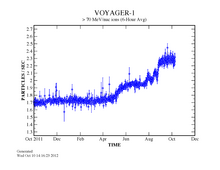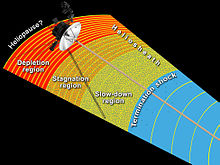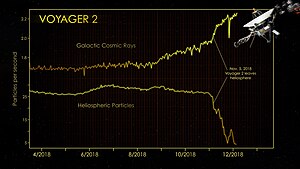Cosmic Ray Subsystem


Cosmic Ray Subsystem(CRS,orCosmic Ray System)[1]is an instrument aboard theVoyager 1andVoyager 2spacecraft of the NASAVoyager program,and it is an experiment to detectcosmic rays.[2][3]The CRS includes a High-Energy Telescope System (HETS), Low-Energy Telescope System (LETS), and The Electron Telescope (TET).[4]It is designed to detect energetic particles and some of the requirements were for the instrument to be reliable and to have enough charge resolution.[5]It can also detect the energetic particles like protons from theGalaxyor Earth'sSun.[1]
As of 2019, CRS is one of the active remaining instruments on both Voyager spacecraft, and it is described by as being able to detect electrons from 3–110 MeV and cosmic ray nuclei 1–500 MeV/n.[6]All three systems usedsolid-statedetectors.[7]CRS is one of the five fields and particle experiments on each spacecraft, and one of the goals is to gain a deeper understanding of thesolar wind.[8]Other objects of study includingelectronsandnucleifrom planetarymagnetospheresand from outside the solar system.[9]
In the summer of 2019, the heater for the CRS onVoyager 2was turned off to save power, however, although it cooled off it was still returning data at a new lower temperature outside its original operating range.[10]The amount of power on the Voyager spacecraft has been slowly decreasing, so various items of equipment are turned off to save power.[10]
Overview[edit]

Areas of original study for this investigation:[11]
- origin and acceleration process, life history, and dynamic contribution of interstellar cosmic rays,
- nucleosynthesisof elements in cosmic-ray sources
- behavior of cosmic rays in theinterplanetary medium
- trapped planetary energetic particle environment.
High-Energy Telescope System:[4]
- 6 and 500 MeV/nucleon foratomic numbersfrom 1 through 30
- Electronsfrom 3 and 100 MeV
Low-Energy Telescope System:[4]
- 0.15 and 30 MeV/nucleon for atomic numbers from 1 to 30.
- Measuresanisotropiesof electrons and nuclei.
Electron Telescope (TET):
- The TET measures the energy spectrum of electrons from 3 to 110 MeV.[4]
The TET consists of eight solid state detectors with different thicknesses oftungstenbetween each detector.[12]The detectors and tungsten layers are stacked one on top of each other.[13]The tungsten layers range from 0.56 mm to 2.34 mm thick and function as absorbers. Each TET solid state detector has an area of 4.5 cm2and is 3 mm thick.[13]
The principal investigator is Prof.Edward C. Stone,Jr.[14]
The CRS was tested to operate down to a temperature of minus 49 degrees F (minus 59 degrees C) during its development in the 1970s.[10]
Operating Temperature[edit]
During its development the CRS was rated to operate down to a temperature of minus 49 degrees F (minus 45 degrees C).[10]Up until 2019 the instrument was operated on bothVoyager 1andVoyager 2,however in the summer of 2019 there was need to save some power onVoyager 2.[10]The heater for the CRS was turned off at this time, which caused a lowering of the CRS temperature to below its lowest rated operating temperature.[10]The device cooled down to minus 74 degrees Fahrenheit (minus 59 degrees Celsius) but it still continued to operate at this temperature.[10]
Results[edit]



In 1977 the spectra of helium, carbon, nitrogen, oxygen, and neon during thesolar minimumwas measured using the CRS instrument on the Voyagers that year.[16]The solar minimum of 1977 occurred towards the end of year, and it was possible to observe both interplanetary, galactic, and anomalous energy spectra.[16]
In the early 1980s, the CRS detected charged particles aroundSaturn.[17]It detected a 0.43 million volt flux of protons as it traveled through Saturn'smagnetosphere.[17]In the 1980s the CRS data from both Voyagers was used to determine the abundances of energetic particles from the Sun and additional information.[18]Another area studied in the 1980s using CRS data was variation ingalactic cosmic raysin the outer Heliosphere[19]
CRS helped predict thatVoyager 1and2would cross the Solar System's termination shock in 2003.[20]This helped support the later conclusion thatVoyager 1crossed the termination shock in December 2004 and thatVoyager 2crossed it in August 2007.[21]
In 2011, CRS data along with the VoyagerMagnetometerdiscovered an area where the solar wind was not going in either direction.[22]The area was identified as a sort of charged particle doldrums, where the particles from the Solar System are pushed back by cosmic forces.[22]At a distance of 17 light-hoursVoyager 1was commanded to rotate several times (in the other direction then its spinning), to make detection in other directions.[21]
It was determined that in 2012Voyager 1entered interstellar space, that is it entered the interstellar medium between the stars.[23]One of the reasons this was recognized was a significant increase in galactic cosmic rays.[24]
In 2013 CRS data lead some to propose thatVoyager 1had entered a "transition zone" as it leaves theheliosphere.[25]There was some changes in the amounts and type of detections that triggered deeper analysis.[26]The results from the magnetometer muddied the waters of interpretation.[27]
First I don't think any of us on the CRS [Cosmic Ray Subsystem, an instrument on Voyager] team will ever forget watching on the computer monitors, even on an hourly basis, in one case, as some particle intensities dropped precipitously, and others increased simultaneously on several occasions in July and August, 2012.
— [28]
Other scientists proposed that this indicated a departure from the Solar System in the sense that it had left the Sun's heliosphere.[26]The issue was the interpretation of the drop in cosmic rays, which happened at 123 AU from the Sun forVoyager 2that year.[26]The many revelations and restructured understandings as the Voyagers head out, as influenced by data from the CRS and other active instruments, was called byNaturepublication as the "long goodbye".[21]
The CRS onVoyager 2,helped identify that spacecraft's departure from the Sun's heliosphere in 2018.[10]
CRS location[edit]

See also[edit]
- Cosmic-ray observatory
- New Horizons(see plasma and high-energy particle spectrometer suite)
- Local Interstellar Cloud
References[edit]
- ^abTeam, Voyager Cosmic Ray Subsystem."OBJECTIVES".voyager.gsfc.nasa.gov.Retrieved2017-01-13.
- ^"NASA - NSSDCA - Experiment - Details for Voyager 2".nssdc.gsfc.nasa.gov.Retrieved2017-01-13.
- ^"NASA - NSSDCA - Experiment - Details for Voyager 1".nssdc.gsfc.nasa.gov.Retrieved2017-01-13.
- ^abcd"NASA - NSSDCA - Experiment - Details".nssdc.gsfc.nasa.gov.Retrieved2017-01-13.
- ^Stone, E. C.; Vogt, R. E.; McDonald, F. B.; Teegarden, B. J.; Trainor, J. H.; Jokipii, J. R.; Webber, W. R. (1977). "1977SSRv...21..355S Page 355".Space Science Reviews.21(3): 355.Bibcode:1977SSRv...21..355S.doi:10.1007/BF00211546.S2CID121390660.
- ^JPL.NASA.GOV."Voyager - The Interstellar Mission".voyager.jpl.nasa.gov.Retrieved2017-01-13.
- ^Team, Voyager Cosmic Ray Subsystem."INSTRUMENTS".voyager.gsfc.nasa.gov.Retrieved2017-02-02.
- ^Evans, Ben; Harland, David M. (2008).NASA's Voyager Missions: Exploring the Outer Solar System and Beyond.Springer Science & Business Media. p. 67.ISBN978-1-85233-745-2.
- ^Doody, Dave (2010).Deep Space Craft: An Overview of Interplanetary Flight.Springer Science & Business Media. p. 218.ISBN978-3-540-89510-7.
- ^abcdefghi"A New Plan for Keeping NASA's Oldest Explorers Going".NASA/JPL.Retrieved2019-09-22.
- ^"NASA - NSSDCA - Experiment - Details".nssdc.gsfc.nasa.gov.Retrieved2017-01-13.
- ^Team, Voyager Cosmic Ray Subsystem."INSTRUMENTS".voyager.gsfc.nasa.gov.Retrieved2017-02-02.
- ^abTeam, Voyager Cosmic Ray Subsystem."Voyager Cosmic Ray Subsystem".voyager.gsfc.nasa.gov.Archived fromthe originalon 2017-02-12.Retrieved2017-02-11.
- ^"NASA - NSSDCA - Experiment - Details".nssdc.gsfc.nasa.gov.Retrieved2017-02-02.
- ^Brown, Dwayne; Fox, Karen; Cofield, Calia; Potter, Sean (December 10, 2018)."Release 18-115 - NASA's Voyager 2 Probe Enters Interstellar Space".NASA.RetrievedDecember 10,2018.
- ^abC., Cummings, A.; C., Stone, E.; R., Webber, W. (15 December 1984)."Evidence that the anomalous cosmic-ray component is singly ionized".Astrophysical Journal Letters.287:L99–L103.Bibcode:1984ApJ...287L..99C.doi:10.1086/184407.Archived fromthe originalon 11 February 2017.Retrieved11 February2017.
{{cite journal}}:CS1 maint: multiple names: authors list (link) - ^abBöhme, S.; Fricke, W.; Hefele, H.; Heinrich, I.; Hofmann, W.; Krahn, D.; Matas, V. R.; Schmadel, L. D.; Zech, G. (2013).Astronomy and Astrophysics Abstracts: Literature 1982.Springer Science & Business Media. p. 343.ISBN978-3-662-12334-8.
- ^Böhme, S.; Esser, U.; Fricke, W.; Hefele, H.; Heinrich, I.; Hofmann, W.; Krahn, D.; Matas, V. R.; Schmadel, L. D. (2013).Literature 1985.Springer Science & Business Media. p. 380.ISBN978-3-662-11178-9.
- ^McDonald, F. B.; Lal, N. (1987). "Variations of Galactic Cosmic Rays with Heliolatitude in the Outer Heliosphere".International Cosmic Ray Conference.3:393.Bibcode:1987ICRC....3..393M.
- ^"cosmic-ray subsystem".Oxford Reference.Oxford University Press.Archivedfrom the original on 19 April 2022.
- ^abcCowen, Ron (5 September 2012)."Voyager's long goodbye".Nature.489(7414): 20–21.Bibcode:2012Natur.489...20C.doi:10.1038/489020a.PMID22962703.
- ^abDiaz, Jesus (5 December 2011)."Voyager Discovers Cosmic Purgatory".
- ^"How Do We Know When Voyager Reaches Interstellar Space?".NASA/JPL.
- ^"How Do We Know When Voyager Reaches Interstellar Space?".NASA/JPL.Retrieved2017-02-11.
- ^Cowen, Ron (2013)."So, has Voyager 1 left the Solar System? Scientists face off".Nature.doi:10.1038/nature.2013.12662.S2CID124689125.
- ^abcCowen, Ron (2013)."So, has Voyager 1 left the Solar System? Scientists face off".Nature.doi:10.1038/nature.2013.12662.S2CID124689125.
- ^Oakes, Kelly."Voyager is in a new region of space, and now that place has a name".Scientific American Blog Network.Retrieved2017-02-11.
- ^Oakes, Kelly."Voyager is in a new region of space, and now that place has a name".
External links[edit]
- Cosmic ray investigation for the Voyager missions: Energetic particle studies in the outer heliosphere – and beyond, Stone, et al
- NASA – Cosmic Rays(general overview of CR)
- Objective of CRS
- Papers by decade from CRS
- CRS
- Voyager Instruments – Cosmic Ray Subsystem
- CRS – Graphs
- TET info
- A New Plan for Keeping NASA's Oldest Explorers Going (July 2019)
